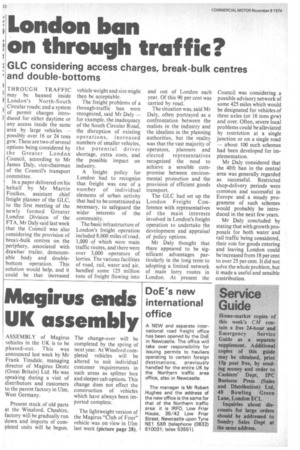London ban on through traffic?
Page 24

If you've noticed an error in this article please click here to report it so we can fix it.
GLC considering access charges, break-bulk centres and double-bottoms
THROUGH TRAFFIC may be banned inside London's North-South Circular roads; and a system of permit charges introduced for either daytime or any access inside the same area by large vehicles — possibly over 16 or 24 tons gvw. These are two of several options being considered by the Greater London Council, according to Mr James Daly, vice-chairman of the Council's transport committee.
In a paper delivered on his behalf by Mr Martin Foulkes, assistant chief freight planner of the GLC, to the first meeting of the newly formed Greater London Division of the FTA, Mr Daly said last week that the Council was also considering the provision of break-bulk centres on the periphery, associated with drawbar trailer, demountable body and doublebottom operation. This solution would help, and it could be that increased vehicle weight and size might then be acceptable.
The freight problems of a through-traffic ban were recognized, said Mr Daly — for example, the inadequacy of the South Circular Road, the disruption of existing operations, increased numbers of smaller vehicles, the potential driver shortage, extra costs, and the possible impact on industry.
A freight policy for London had to recognize that freight was one of a number of individual elements of urban activity that had to be constrained as necessary, to safeguard the wider interests of the community.
The basic infrastructure of London's freight operation included 8,000 miles of road, 1,000 of which were main traffic routes, and there were over 3,000 operators of lorries. The various facilities of road, rail, water and air, handled some 125 million tons of freight flowing into and out of London each year. Of this 90 per cent was carried by road.
The situation was, said Mr Daly, often portrayed as a confrontation between the realists in the industry and the idealists in the planning authorities, but the reality was that the vast majority of operators, planners and elected representatives recognized the need to achieve a sensible compromise between environmental protection and the provision of efficient goods transport.
The GLC had set up the London Freight Conference with representatives of the main interests involved in London's freight operation to undertake the development and appraisal of policy options.
Mr Daly thought that there appeared to be significant advantages particularly in the long term to adopting a limited network of main lorry routes in London. At present the Council was considering a possible advisory network of some 425 miles which would be designated for vehicles of three axles (or 16 tons gvw) and over. Often, severe local problems could be alleviated by restriction at a single junction or on a single road — about 100 such schemes had been developed for implementation.
Mr Daly considered that the 40 ft ban in the central area was generally regarded as successful. Restricted shop-delivery periods were common and successful in Europe and a steady programme of such schemes would probably be introduced in the next few years.
Mr Daly concluded by stating that with growth proposals for both water and rail traffic being considered, their role for goods entering and leaving London could be increased from 18 per cent to over 25 per cent. It did not solve the whole problem, but it made a useful and sensible contribution.




































































































































































































